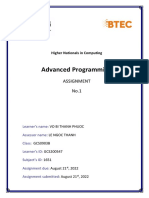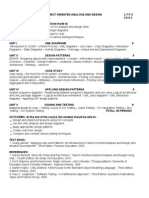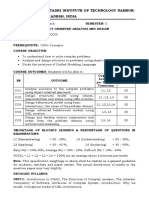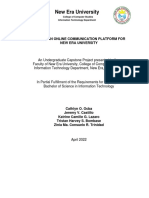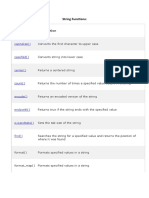0 ratings0% found this document useful (0 votes)
2 viewsAssignment oop
This assignment focuses on Object-Oriented Software Engineering using UML, requiring students to create UML diagrams for an online banking system and a library management system. It includes tasks related to UML modeling, object-oriented design principles, reusable technology, requirement development, and class modeling. Students must submit a well-formatted document with thorough explanations and appropriate diagrams.
Uploaded by
awadkarimomerCopyright
© © All Rights Reserved
Available Formats
Download as DOCX, PDF, TXT or read online on Scribd
0 ratings0% found this document useful (0 votes)
2 viewsAssignment oop
This assignment focuses on Object-Oriented Software Engineering using UML, requiring students to create UML diagrams for an online banking system and a library management system. It includes tasks related to UML modeling, object-oriented design principles, reusable technology, requirement development, and class modeling. Students must submit a well-formatted document with thorough explanations and appropriate diagrams.
Uploaded by
awadkarimomerCopyright
© © All Rights Reserved
Available Formats
Download as DOCX, PDF, TXT or read online on Scribd
You are on page 1/ 3
Assignment – Object-Oriented Software Engineering Practical Development Using UML
Instructions:
Answer all questions.
Use UML diagrams to illustrate your solutions where applicable.
Submit the assignment in a well-formatted document (PDF or Word).
Make sure your answers are thorough and include appropriate explanations for each step.
For UML diagrams, you can use UML tools like Lucidchart, Visual Paradigm, or
draw.io.
Section 1: UML Modeling (15 marks)
1. Use Case Diagram (5 marks):
o Imagine you are designing an online banking system. Create a Use Case
Diagram for the system that includes the following actors and use cases:
Actors: Customer, Bank Employee, System
Use Cases:
Customer: View Account, Transfer Funds, Pay Bills
Bank Employee: Verify Transactions, Manage Account
System: Authenticate Users
o Task: Draw a Use Case Diagram that shows how these actors interact with the
system. Provide a brief explanation of each use case.
2. Class Diagram (10 marks):
o Based on the Use Case Diagram you created, design a Class Diagram for the
online banking system. Include the following classes:
Customer
Account
Transaction
BankEmployee
o Define attributes and methods for each class.
o Show the relationships between the classes (e.g., associations, inheritance, etc.).
o Task: Draw the Class Diagram and provide a brief description of each class and
its role in the system.
Section 2: Object-Oriented Design Principles (15 marks)
3. Encapsulation and Inheritance (7 marks):
o Consider the following scenario: You are designing a Library Management
System with the following objects:
Book (with title, author, ISBN)
Member (with name, membership type)
Librarian (inherits from Member, with additional admin privileges)
o Task:
Define how Encapsulation is applied in the system to protect data (e.g.,
private fields and public getter/setter methods).
Explain the Inheritance relationship between Member and Librarian.
4. Polymorphism (8 marks):
o Task: Write a short description of how Polymorphism can be used in the
Library Management System to handle different types of transactions, such as:
Borrowing a book (for a Member)
Returning a book (for a Member)
Processing fines (for a Librarian)
o Show how polymorphism allows the system to handle these actions in a unified
way (i.e., using the same method name for different transaction types).
Section 3: Reusable Technology (10 marks)
5. Reusable Components (5 marks):
o Task: Explain the concept of reusable components in software development.
Discuss at least two reusable components that can be used in the online banking
system you designed in Section 1.
o Provide examples of how these components help reduce development time and
improve system maintainability.
6. Design Patterns (5 marks):
o Task: Choose a design pattern (e.g., Singleton, Factory, Observer, Strategy) and
explain how it could be applied in the online banking system to solve a specific
problem (e.g., account management, transaction processing).
o Provide an example of how this pattern would be implemented in your system.
Section 4: Requirement Development (10 marks)
7. Requirement Gathering (5 marks):
o Task: Choose a software project of your choice (e.g., e-commerce platform,
inventory management system).
o List five functional requirements and five non-functional requirements for the
system.
o Provide brief explanations for each requirement.
8. Requirement Traceability (5 marks):
o Task: Explain the concept of requirement traceability and how it helps ensure
that all system requirements are met during development.
o Create a simple traceability matrix linking the requirements to specific design
elements (e.g., classes, methods) in the system you modeled in Section 1.
Section 5: Class Modeling and UML Tools (10 marks)
9. UML Tool Usage (5 marks):
o Task: Choose a UML tool (e.g., Lucidchart, Visual Paradigm, or draw.io) and
create a detailed Class Diagram for the Library Management System based on
your design in Section 2.
o Submit a screenshot or exported image of the Class Diagram.
10. Class Modeling with Relationships (5 marks):
o Task: Model the relationships between classes in the Library Management
System. Include the following:
Aggregation between Library and Book
Association between Member and Transaction
o Draw a UML diagram showing these relationships and provide a brief
explanation of each.
Submission Guidelines:
Submit the assignment as a PDF or Word document.
Include all relevant UML diagrams (drawn in UML tools) and descriptions.
Ensure the diagrams are clear, labeled, and easy to understand.
Provide explanations for each section to demonstrate your understanding of the concepts.
You might also like
- 1651 - Advanced Programming - Võ Bì Thành Phư C - GCS200547 - Assignment 1No ratings yet1651 - Advanced Programming - Võ Bì Thành Phư C - GCS200547 - Assignment 138 pages
- Sentiment Analysis of Restaurant Review - Project ReportNo ratings yetSentiment Analysis of Restaurant Review - Project Report20 pages
- CS8582 Object Oriented Analysis and Design LaboratoryNo ratings yetCS8582 Object Oriented Analysis and Design Laboratory2 pages
- CS8582 Object Oriented Analysis and Design Laboratory L T P C 0 0 4 2No ratings yetCS8582 Object Oriented Analysis and Design Laboratory L T P C 0 0 4 21 page
- Assignment on UML Design for Software ProjectsNo ratings yetAssignment on UML Design for Software Projects4 pages
- Object Oriented Analysis and Design For R-2013 by Krishna Sankar P., Shangaranarayanee N.P.No ratings yetObject Oriented Analysis and Design For R-2013 by Krishna Sankar P., Shangaranarayanee N.P.3 pages
- Final Examination: SUBJECT: Software Engineering (ID: IT076IU)No ratings yetFinal Examination: SUBJECT: Software Engineering (ID: IT076IU)5 pages
- Roshan Christy Bolonne 20147455: Student Details (Student Should Fill The Content)No ratings yetRoshan Christy Bolonne 20147455: Student Details (Student Should Fill The Content)34 pages
- WWW - Manaresults.co - In: Object Oriented Analysis & Design Using UmlNo ratings yetWWW - Manaresults.co - In: Object Oriented Analysis & Design Using Uml4 pages
- Bca Object Oriented Analysis and Design_qpNo ratings yetBca Object Oriented Analysis and Design_qp2 pages
- Assignment Cover Sheet Qualification Module Number and TitleNo ratings yetAssignment Cover Sheet Qualification Module Number and Title13 pages
- Cs6502 Object Oriented Analysis and Design SyllabusNo ratings yetCs6502 Object Oriented Analysis and Design Syllabus2 pages
- Bvraju Institute of Technology, Narsapur: Code No: R14No ratings yetBvraju Institute of Technology, Narsapur: Code No: R142 pages
- Objectives:: Cs8582 Object Oriented Analysis and Design Laboratory L T P C 0 0 4 2No ratings yetObjectives:: Cs8582 Object Oriented Analysis and Design Laboratory L T P C 0 0 4 22 pages
- HCT210: Software Engineering: 2019 Semester 2 Assignment 2: DesignNo ratings yetHCT210: Software Engineering: 2019 Semester 2 Assignment 2: Design3 pages
- Assignment 3 - Design Implementation-2024No ratings yetAssignment 3 - Design Implementation-20245 pages
- IT6513 CASE TOOLS LABORATORY & ooad syllabusesNo ratings yetIT6513 CASE TOOLS LABORATORY & ooad syllabuses4 pages
- CIS6003 Advanced Programming: Student Details (Student Should Fill The Content)No ratings yetCIS6003 Advanced Programming: Student Details (Student Should Fill The Content)9 pages
- LD7092 Principles of Software Engineering 202425No ratings yetLD7092 Principles of Software Engineering 2024256 pages
- OOAD_JAVA_AssignmentQuestionPaper_Semester1_2020No ratings yetOOAD_JAVA_AssignmentQuestionPaper_Semester1_202011 pages
- HCT210: Software Engineering: Assignment 2: Design and Software QualityNo ratings yetHCT210: Software Engineering: Assignment 2: Design and Software Quality3 pages
- (Ebook) Modular Synthesis: Patching Machines and People by Ezra J. Teboul, Andreas Kitzmann, Einar Engström ISBN 9781040015759, 9781003219484, 1040015751, 1003219489 2024 scribd download100% (3)(Ebook) Modular Synthesis: Patching Machines and People by Ezra J. Teboul, Andreas Kitzmann, Einar Engström ISBN 9781040015759, 9781003219484, 1040015751, 1003219489 2024 scribd download81 pages
- Instant Access to GMAT Advanced Quant 250 Practice Problems Online Resources Manhattan Prep GMAT Strategy Guides 3rd Edition Manhattan Prep ebook Full Chapters100% (3)Instant Access to GMAT Advanced Quant 250 Practice Problems Online Resources Manhattan Prep GMAT Strategy Guides 3rd Edition Manhattan Prep ebook Full Chapters18 pages
- ARK - Intel® Core™ I5-3230m Processor (3M Cache, Up To 3No ratings yetARK - Intel® Core™ I5-3230m Processor (3M Cache, Up To 34 pages
- Multiples of A Given Number Up To 100: Study The Table Below. Answer What Is AskedNo ratings yetMultiples of A Given Number Up To 100: Study The Table Below. Answer What Is Asked14 pages
- Digital Literacy and Cyberbullying Behav 5ef9de18No ratings yetDigital Literacy and Cyberbullying Behav 5ef9de1824 pages
- Calculating Memory System Power For DDR3r PDFNo ratings yetCalculating Memory System Power For DDR3r PDF24 pages
- Role Based Access Control Second Edition David F. Ferraiolo - Get instant access to the full ebook with detailed contentNo ratings yetRole Based Access Control Second Edition David F. Ferraiolo - Get instant access to the full ebook with detailed content52 pages
- Cloud Security (Sample Question Bank) (2)No ratings yetCloud Security (Sample Question Bank) (2)26 pages
- Delfi: Online Planner Selection For Cost-Optimal Planning: Michael Katz and Shirin Sohrabi and Horst SamulowitzNo ratings yetDelfi: Online Planner Selection For Cost-Optimal Planning: Michael Katz and Shirin Sohrabi and Horst Samulowitz12 pages
- Cyberviser Company Profile With Logo VersionNo ratings yetCyberviser Company Profile With Logo Version4 pages
- U6 - M2 - L6 - Microservice Architecture - Benefits and Drawbacks - Annotated - TaggedNo ratings yetU6 - M2 - L6 - Microservice Architecture - Benefits and Drawbacks - Annotated - Tagged13 pages
- Threat and Risk Assessment Working GuideNo ratings yetThreat and Risk Assessment Working Guide119 pages
- Chang et al._2009_Visualizing the Republic of LettersNo ratings yetChang et al._2009_Visualizing the Republic of Letters2 pages


